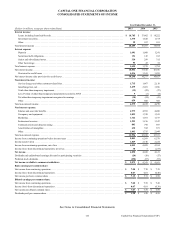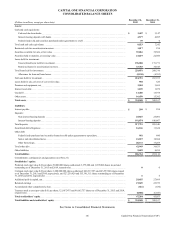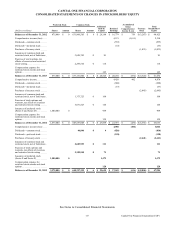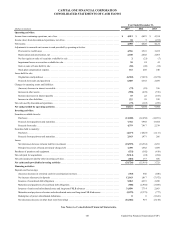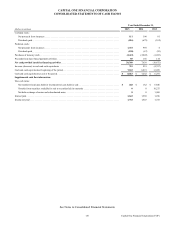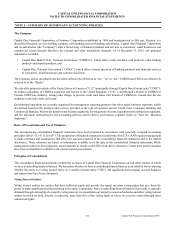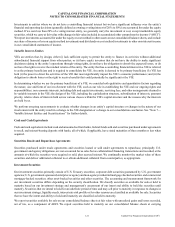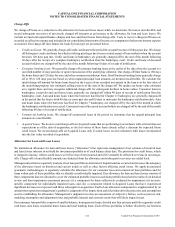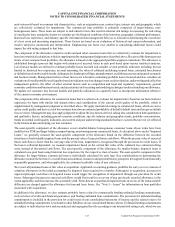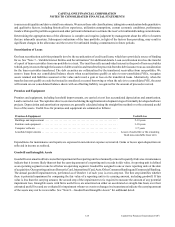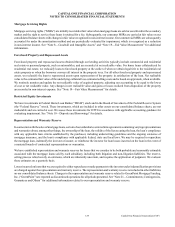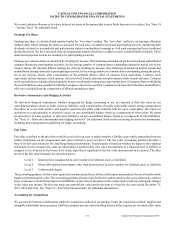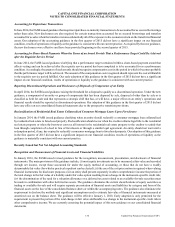Capital One 2015 Annual Report Download - page 143
Download and view the complete annual report
Please find page 143 of the 2015 Capital One annual report below. You can navigate through the pages in the report by either clicking on the pages listed below, or by using the keyword search tool below to find specific information within the annual report.CAPITAL ONE FINANCIAL CORPORATION
NOTES TO CONSOLIDATED FINANCIAL STATEMENTS
124 Capital One Financial Corporation (COF)
or pool of loans, using the effective interest method. The difference between total contractual payments on the loans and all expected
cash flows represents the nonaccretable difference or the amount of principal and interest not considered collectible.
Subsequent to acquisition, we evaluate our estimate of cash flows expected to be collected on a quarterly basis. These evaluations
require the use of key assumptions and estimates similar to those used in estimating the initial fair value at acquisition. Subsequent
changes in the estimated cash flows expected to be collected may result in changes in the accretable yield and nonaccretable
difference or reclassifications from the nonaccretable difference to the accretable yield. Decreases in expected cash flows resulting
from credit deterioration subsequent to acquisition will generally result in an impairment charge recognized in our provision for
credit losses and an increase in the allowance for loan and lease losses. Charge-offs are not recorded until the expected credit losses
within the nonaccretable difference are depleted. In addition, Acquired Loans are not classified as delinquent or nonperforming
as we expect to collect our net investment in these loans. Increases in the cash flows expected to be collected would first reduce
any previously recorded allowance for loan and lease losses established subsequent to acquisition. The excess over the recorded
allowance for loan and lease losses would result in a reclassification to the accretable yield from the nonaccretable difference and
an increase in interest income recognized over the remaining life of the loan or pool of loans. Disposals of loans in the form of
sales to third parties, receipt of payment in full or in part by the borrower, and foreclosure of the collateral, result in removal of
the loan from the Acquired Loans portfolio. See “Note 5—Loans” for additional information.
Loans Acquired and Accounted for Based on Contractual Cash Flows
To determine the fair value of loans at acquisition in a business combination, we estimate discounted contractual cash flows due
using an observable market rate of interest, when available, adjusted for factors that a market participant would consider in
determining fair value. In determining fair value, contractual cash flows are adjusted to include prepayment estimates based upon
trends in default rates and loss severities. The difference between the fair value and the contractual cash flows is recorded as a
loan discount or premium at acquisition. Subsequent to acquisition, the loans are classified and accounted for as either held for
investment or held for sale based on management’s ability and intent. Loans held for investment are subject to our allowance for
loan and lease losses methodology described below under “Allowance for Loan and Lease Losses.”
We are permitted to aggregate loans acquired in the same fiscal quarter into one or more pools if the loans have common risk
characteristics. If we elect to pool loans, a pool is then accounted for as a single asset with a single composite interest rate and an
aggregate fair value and expected cash flows.
Loan Modifications and Restructurings
As part of our loss mitigation efforts, we may provide modifications to a borrower experiencing financial difficulty to improve
long-term collectability of the loan and to avoid the need for foreclosure or repossession of collateral. A loan modification in which
a concession is granted to a borrower experiencing financial difficulty is accounted for and reported as a troubled debt restructuring
(“TDR”). Our loan modifications typically include an extension of the loan term, a reduction in the interest rate, or a combination
of both. We describe our accounting for and measurement of impairment on restructured loans below under “Impaired Loans.”
See “Note 5—Loans” for additional information on our loan modifications and restructurings.
Delinquent and Nonperforming Loans
The entire balance of a loan is considered contractually delinquent if the minimum required payment is not received by the first
statement cycle date equal to or following the due date specified on the customer’s billing statement. Delinquency is reported on
loans that are 30 or more days past due. Interest and fees continue to accrue on past due loans until the date the loan is placed on
nonaccrual status, if applicable. We generally place loans on nonaccrual status when we believe the collectability of interest and
principal is not reasonably assured.
Nonperforming loans generally include loans that have been placed on nonaccrual status. As described above, we do not report
loans classified as held for sale as nonperforming.
Our policies for classifying loans as nonperforming, by loan category, are as follows:
• Credit card loans: As permitted by regulatory guidance issued by the Federal Financial Institutions Examination Council
(“FFIEC”), our policy is generally to exempt credit card loans from being classified as nonperforming as these loans are
generally charged off in the period the account becomes 180 days past due. Consistent with industry conventions, we
generally continue to accrue interest and fees on delinquent credit card loans until the loans are charged-off. We classify


